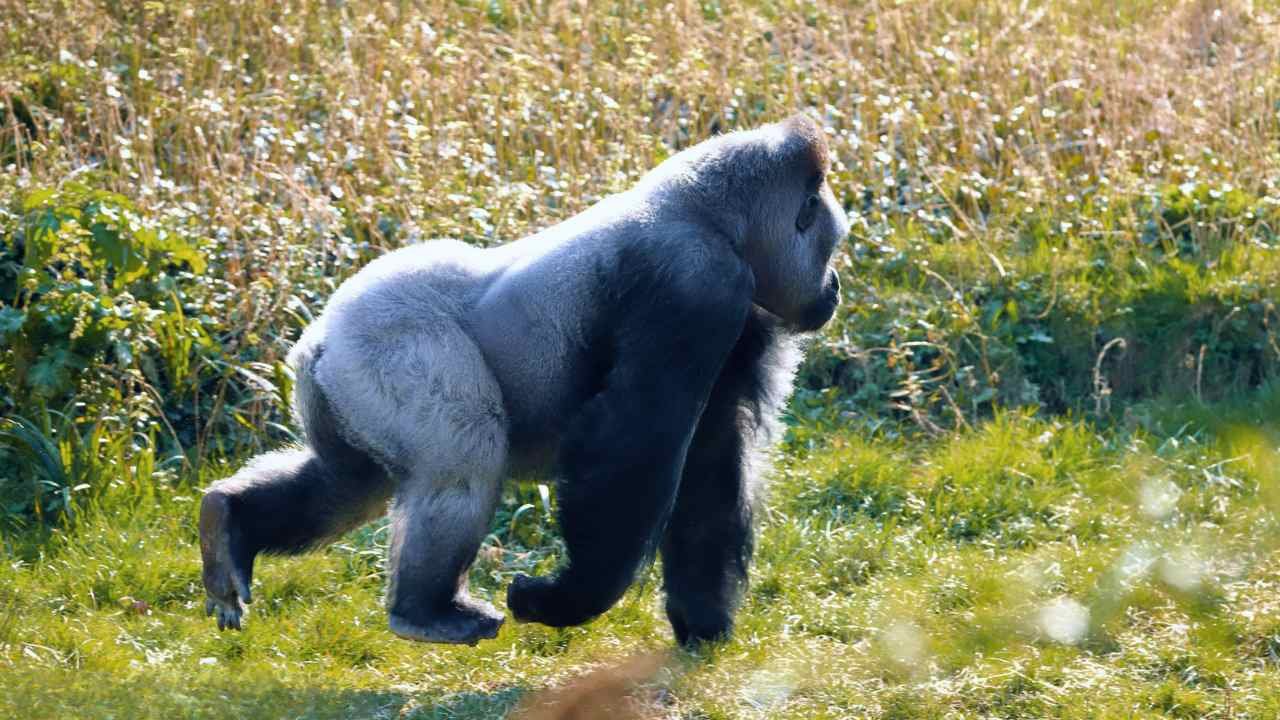Ever wondered, “how fast can gorillas run?” These majestic creatures, known for their strength and intelligence, have a surprising turn of speed that often goes unnoticed. Dive into our comprehensive guide to discover the running prowess of gorillas, how they compare to other animals, and whether you stand a chance in a footrace against them!
Gorillas are large primates that live in the forests of central Africa. They are the biggest of all primates, which means they’re related to us, humans! Just like us, they have two arms, two legs, and walk on their knuckles. They have strong bodies covered in dark hair and are known for their big heads with a wide face.
Why Should We Know About Their Strength?

Knowing how strong gorillas are helps us understand them better. Imagine you’re reading a superhero comic. To understand the hero’s powers, you need to know how strong they are, right? It’s the same with gorillas. By learning about their strength and speed, we can figure out how they live, find food, and stay safe in the wild. Plus, it’s just cool to know how powerful these amazing animals are!
Gorilla Anatomy and Physiology

Gorillas are incredibly strong, and a lot of that strength comes from their muscles. Their bodies are built for power, especially their legs. Have you ever seen the thick, sturdy legs of a gorilla? Those legs are packed with muscles that help them move through the dense forests and climb trees. The muscles in their thighs and calves are much bigger and stronger than ours. This is because they need to support their heavy bodies and move quickly when needed.
Gorillas vs. Humans: A Body Comparison

Now, let’s compare gorillas with us, humans. Imagine you’re standing next to a gorilla. The first thing you might notice is how much broader and bulkier they are. While we walk on the soles of our feet, gorillas walk on their knuckles. This is called “knuckle-walking.” Their arms are longer than ours, which helps them do this.
But what about the inside? If we peek inside (not literally, of course!), we’d see that gorillas have a lot more muscle mass than we do. Their leg muscles, especially, are built for power and not for long-distance running like ours. So, while we might be better at running marathons, gorillas have the strength to move heavy objects and climb with ease.
In short, while there are some similarities between gorillas and humans, our bodies are designed for different lifestyles. We’re built for endurance and versatility, while gorillas are built for strength and power in their forest homes.
How Fast Can Gorillas Run

When we think of fast animals, gorillas might not be the first to come to mind. However, these powerful primates can surprise you with their speed! On average, gorillas can run at speeds of up to 20 to 25 miles per hour (mph). That’s pretty fast, especially when you consider their size and weight.
Does Age, Gender, or Other Factors Change Their Speed?
Just like humans, not all gorillas are the same. Their speed can vary based on several factors:
- Age: Younger gorillas, full of energy and curiosity, might move faster than older ones. As gorillas age, just like people, their strength and speed might decrease a bit.
- Gender: Male gorillas, known as silverbacks because of the silver hair on their backs, are generally larger and more muscular than females. While they have the strength, their bulk can sometimes mean they’re not as fast as the lighter females.
- Situation: Gorillas don’t always run at their top speed. If they’re just moving around their home in the forest, they might go slower. But if they feel threatened or are chasing something, they can pick up the pace quickly!
Factors Affecting Gorilla Speed
The Ground Beneath Their Feet: Terrain Matters The place where a gorilla is running can make a big difference in how fast they go. Let’s break it down:
- Forest Floor: Gorillas mainly live in dense forests. The forest floor can be uneven, with roots, rocks, and fallen branches. While gorillas are used to this terrain, it can slow them down a bit because they have to watch where they step.
- Open Ground: On open ground, like clearings or meadows, gorillas can move faster. There’s less to trip over, so they can really get going!
- Uphill: Going uphill is hard work, even for strong gorillas. They might slow down a bit as they climb.
- Downhill: Going downhill can be tricky. Gorillas will be careful to not go too fast and lose control, especially on steep slopes.
When Danger Looms: Threats Gorillas are pretty peaceful animals, but sometimes they need to run:
- Escaping Predators: While adult gorillas don’t have many natural enemies, young gorillas can be at risk from leopards. If a gorilla senses danger, they’ll run to protect the younger members of their group.
- Defending Territory: Male gorillas, or silverbacks, might run to chase away another male trying to take over their family group. It’s all about showing who’s boss!
Feeling Good: Physical Condition Just like us, a gorilla’s health and fitness can affect how fast they move:
- Age: Young gorillas are like kids – full of energy! They might run around more and at faster speeds. Older gorillas might be a bit slower, taking their time as they move.
- Health: A sick gorilla won’t move as fast as a healthy one. Just like when we’re not feeling well, they’ll want to rest and recover.
- Fitness Level: Gorillas that are active and play, climb, and explore a lot might be faster because they’re in better shape. Those that are more laid-back and relaxed might not have the same speed.
In the end, many things can affect how fast a gorilla runs. Whether it’s the ground they’re running on, dangers in the area, or how they’re feeling that day, these factors all play a part in a gorilla’s need for speed!
Comparison with Other Animals

Gorillas vs. Other Primates:
When we think of primates, we often picture them swinging from trees rather than running on the ground. But how does the gorilla’s speed stack up against its primate relatives?
- Chimpanzees: These close relatives of gorillas (and us!) are quite agile. On the ground, chimps can reach speeds of up to 25 mph, which is similar to gorillas. However, they’re more at home in the trees, where they swing and climb with ease.
- Orangutans: Native to the rainforests of Borneo and Sumatra, orangutans are more arboreal (tree-dwelling) and aren’t known for their speed on the ground. They’re slower than gorillas, with speeds of around 3-4 mph.
- Baboons: These ground-dwelling primates can be pretty fast when they want to be, reaching speeds of up to 30 mph. That’s a bit faster than gorillas!
Gorillas vs. Their Neighbours:

The African forests are home to a variety of animals. Let’s see how gorillas compare to some of their neighbors:
- Leopards: These big cats are stealthy hunters and can move quickly when chasing prey. Leopards can reach impressive speeds of up to 36-37 mph in short bursts. That’s faster than gorillas, making them one of the top sprinters in the forest.
- Elephants: The African forest elephant is smaller than its savanna cousin but is still a giant compared to the gorilla. Despite their size, they can be surprisingly fast, reaching speeds of up to 15 mph. While they’re powerful, they’re not as fast as gorillas.
In conclusion, while gorillas are pretty speedy for their size, they’re not the fastest animals in their habitat. Each animal, whether primate or not, has its own set of skills and speeds suited to its lifestyle and needs. Gorillas might not win a forest race, but they’re certainly impressive in their own right!
Can You Outrun a Gorilla?
When imagining a footrace with a gorilla, it’s essential to consider a few things:
Speed Comparison:
- Humans: The average human jogging speed is around 6-8 mph. Even the world’s fastest humans, like sprinters in the Olympics, reach speeds of about 27-28 mph in short bursts. However, this speed is not sustainable over long distances.
- Gorillas: As mentioned earlier, gorillas can run at speeds of up to 20 to 25 mph. This speed is impressive, especially given their size and weight.
Terrain and Distance:
- Short Distances: Over short distances, it’s unlikely that an average person could outrun a gorilla. Their powerful legs give them a quick start, and they can reach their top speed in just a few strides.
- Long Distances: Humans are endurance runners. Our bodies are built for long distances, not short sprints. Over a more extended distance, a human might have an advantage because we can maintain a steady pace for a longer time. Gorillas, on the other hand, are not built for endurance running. They would tire out more quickly.
Motivation: It’s essential to remember that gorillas are generally peaceful creatures. They don’t chase or attack humans without reason. A gorilla would only run after something if it felt threatened or provoked. So, the scenario of being chased by a gorilla is highly unlikely in the first place.
While it might be a fun thought experiment, the reality is that you probably couldn’t outrun a gorilla over a short distance. Over longer distances, with the right conditions, a human might stand a chance due to our endurance capabilities. However, it’s always best to remember that wild animals, including gorillas, should be observed from a safe distance and treated with respect. The best way to “win” in a situation with a gorilla is to avoid any confrontation in the first place!
Frequently Asked Questions (FAQs)
1. Can gorillas run faster than humans?
Yes, gorillas can run faster than the average human. While humans jog at speeds of around 6-8 mph, gorillas can reach speeds of up to 20 to 25 mph in short bursts.
2. Is it possible to outrun a gorilla?
Over short distances, it’s unlikely for an average person to outrun a gorilla due to their quick acceleration and top speed. However, over longer distances, humans might have an advantage because of our endurance capabilities.
3. How hard can a gorilla punch?
While there isn’t a precise measurement for a gorilla’s punch, it’s believed that they can hit with a force up to 2,000 pounds per square inch (psi). That’s much stronger than a trained boxer!
4. How fast is a gorilla in km/h?
Gorillas can run at speeds of up to 32 to 40 km/h.
5. How fast can a human run?
The average human jogging speed is around 9.6-12.8 km/h. The world’s fastest humans, like Olympic sprinters, can reach speeds of about 43-45 km/h in short bursts.
6. How fast can a chimpanzee run?
Chimpanzees can reach speeds of up to 40 km/h, similar to gorillas, especially when they feel threatened or are in a hurry.
7. How fast can a gorilla run 100m?
While there’s no official record, considering their top speed, a gorilla might cover 100 meters in approximately 9 to 11 seconds if they were running at their fastest.
8. How long can a gorilla run for?
Gorillas are not built for endurance running. While they can reach high speeds in short bursts, they would tire out relatively quickly and are not likely to maintain their top speed for extended periods.
9. How fast can a silverback gorilla run?
Silverback gorillas, which are mature male gorillas, can run at speeds similar to other adult gorillas, around 20 to 25 mph or 32 to 40 km/h. However, their larger size and bulk might mean they take a bit longer to reach their top speed.
Remember, these answers are based on current knowledge and research. Gorillas, like all wild animals, can be unpredictable, and their abilities can vary based on individual factors and environmental conditions.

